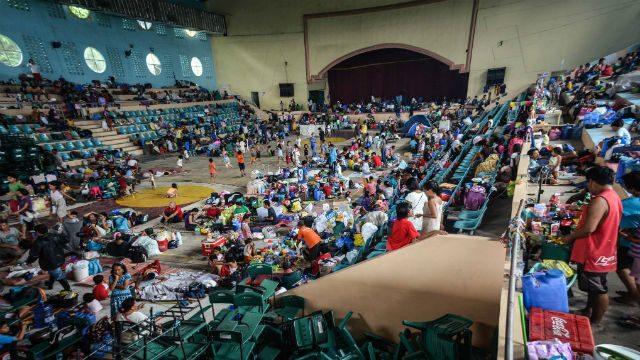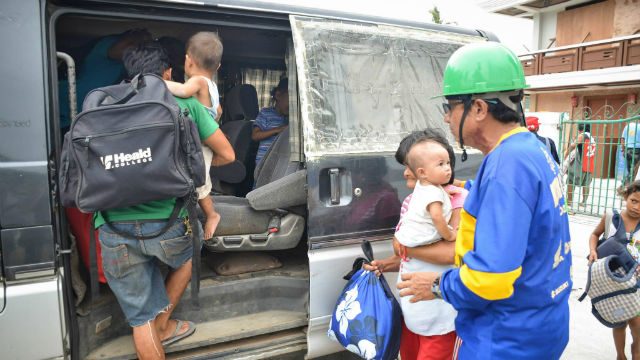SUMMARY
This is AI generated summarization, which may have errors. For context, always refer to the full article.

MANILA, Philippines – As Typhoon Ruby (international name: Hagupit) continued to traverse the Philippine archipelago Monday, December 8, some areas so far registered zero, if not minimal, casualty.
The figures were a far cry from the huge numbers reported when Super Typhoon Yolanda hit the same corridor in 2013.
As of Monday, the National Disaster Risk Reduction and Management Council (NDRRMC) reported that the Typhoon Ruby has claimed 3 lives: two in Iloilo and one in Dolores, Eastern Samar. The Philippine Red Cross, however, stated that 21 people were killed, 18 of whom in Eastern Samar.
According to NDRRMC Executive Director Alexander Pama, they will have to verify additional reports before they can give the final number of casualties.
Typhoon Yolanda claimed more than 6,000 lives and displaced millions when it ravaged the Visayas in November 2013, with many localities caught offguard by storm surges.
In the case of Ruby, however, local governments units (LGUs) and residents in the Visayas were better prepared. Even before the typhoon entered the Philippine Area of Responsibility, local officials coordinated closely with the national government, non-governmental organizations (NGOs), and several local institutitions in ensuring the safety of their constituents. (READ: LGUs prepare for #RubyPH)

Many LGUs conducted preemptive evacuation days before the typhoon came. Coastal communities, such as Barangay 88 in Tacloban City in Leyte, were prioritized. (READ: Village hit hardest by Haiyan evacuates ahead of #RubyPH)
Tacloban City was the area hardest hit by Yolanda last year, recording the most casualties due to the storm surge. The city did not take any chances with Typhoon Ruby.
As early as Friday, December 5, a day before Ruby’s first landfall in the neighboring province of Eastern Samar, Tacloban City in Leyte came up with a list of 18 safe evacuation centers. Among the places considered safe to house more than 3,000 families in total included the Leyte National High School, the Tacloban Astrodome, and the Astrodome.
In Ormoc City, responders immediately moved to safer and higher places at least 260 people already in 3 evacuation centers, which were later threatened by a storm surge. The city rescue reported zero casualty.
//
Vice Mayor Fritzie Odron of Giporlos, Eastern Samar, reported on Facebook that their coastal municipality was spared from maximum damage in terms of infrastructure and casualties.
During last year’s super typhoon, the municipality was in ruins with more than 10 dead. Now, with evacuations taking place before they felt the effect of Typhoon Ruby, the residents are all safe and sound.
Northern Samar has so far reported no deaths or injuries either, only damage to infrastructure. The local government ordered forced evacuation in 24 municipalities as early as Thursday, December 4.
Catarman #NorthernSamar DRRM office reports #ZeroCasualty thanks to preemptive evacuation. #Hagupit #RubyPH
— Plan Philippines (@PlanPhilippines) December 7, 2014
In one of the municipalities, Catarman, the strong winds and intense rain brought by Typhoon Ruby destroyed more than 1,000 houses. Fortunately, in a message relayed to HAM radio operator Roberto Vicencio, Jonathan Baldo of the municipality’s Disaster Risk Reduction and Management Office (DRRMO) said that there was no recorded casualty so far.
In Southern Leyte, at least 70,000 residents were evacuated more than a day before Typhoon Ruby hit their province.
Life goes back to normal for the province as every evacuee has gone home, according to Governor Roger Mercado. No casualty was recorded.
//
Albay, known for its disaster preparedness program, once again registered zero casualty, Governor Joey Salceda declared. The whole Bicol region also reported no typhoon-related death.
//
Based on reports gathered by the NDDRMC from their local counterparts, early evacuation was one of the key factors behind most cities and municipalities’ zero casualty outcome.
Government statistics show 1,034,464 persons were being served in evacuation centers as of 6 pm on Monday, December 8.
NDRRMC also noted that residents were more cooperative and immediately heeded their orders of evacuation. They were more conscious with the possible effects of Typhoon Ruby in their areas.
In addition, the level of preparedness seen were more positive across several LGUs ever since Typhoon Yolanda hit the country.
The different information dissemination techniques adopted by several LGUs and non-governmental organizations (NGOs) days before the typhoon came helped in the campaign. (READ: The role of LGUs, local councils during disasters)
Lessons from Typhoon Yolanda were applied prior and during Typhoon Ruby. These included prepositioning rescue teams, relief goods, and other necessary disaster preparedness and response needs. For example, the Department Social Welfare and Development said it placed more than 80,000 food packs in key areas before the typhoon came.
Still, Pama urged the public to remain vigilant and prepared as Typhoon Ruby was expected to stay in the PAR until Wednesday, December 10, yet. – Rappler.com
Add a comment
How does this make you feel?
There are no comments yet. Add your comment to start the conversation.